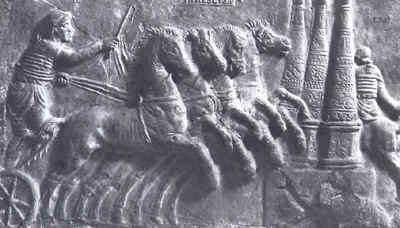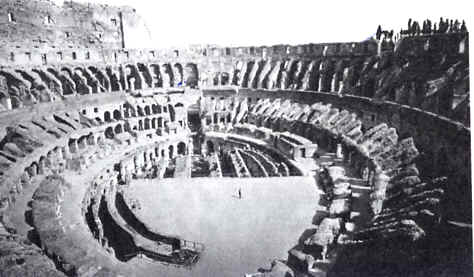Roman entertainment, like Roman roads, Roman baths, Roman villas etc, is etched in people’s minds today as a result of recent films. Many people will know of the Roman gladiators, chariot racing, the Colosseum in Rome as we have a great deal of writing and other evidence about these things from the times of the Romans themselves.
|
Chariot racing |
One of the most famous buildings in Rome is the Colosseum. This building is now a major tourist attraction in Rome. In Ancient Rome it was also a major attraction for those who wanted to see the various events that were put on at this vast building. The Colosseum could hold over 50,000 people and the viewing public were well looked after by the authorities. The temperature in Rome in the summer could be very hot and the audience at the Colosseum was protected from the sun by a huge canopy that was put over the top of the stadium when needed.
|
Inside the ruins of the Colosseuem |
The events staged at the Colosseum were many. Nearly all of them involved death and destruction. There were the well known gladiator fights and the feeding of Christians to lions. There were also a number of lesser known events such as mock sea battles involving ships, animal circus acts, animals fighting animals and animal hunts.
All sorts of animals were kept in cages below the Colosseum. Wild cats, buffaloes, bears and elephants would all be kept and then made to fight one another. In some parts of the Roman Empire, certain animals died out because their type was in such demand by those who ran entertainment in Rome itself. It is thought that on the day the Colosseum opened, over 5,000 animals were killed.
However, animals were the secondary part of the ‘show’. Those who came to the Colosseum came to see people fight. Famous gladiators had a huge following but many gladiators were the Roman equivalent of ‘canon fodder’ – there to entertain and be killed. Many of these gladiators were slaves or prisoners-of-war. The casualty rate per ‘show’ was massive – near enough 50% died each show. Those gladiators who had fought well but had not won their fight could be spared by the emperor if he was present at an event – a thumbs up meant life, and a thumbs down meant death. The Roman writer Seneca wrote that for a gladiator “the only exit is death.”
These shows were usually free to the public. The emperors believed it was a good way to keep the people of Ancient Rome happy and content with the way the city was being governed. The government provided free bread and free entertainment – a combination they believed would keep happy the many unemployed people in Rome.
The Colosseum was the greatest building in Ancient Rome but much smaller amphitheatres were built in Roman Britain and gladiatorial fights may have occurred in these. Cirencester had an amphitheatre.
Chariot racing was put on at the Circus Maximus. This was equally popular with the people of Ancient Rome and going to a race was seen as a family event.
To many people today, Roman entertainment was cruel. However, not all forms of entertainment involved violence. Many educated Romans were appalled by the cruelty of the events put on at the Colosseum. They went to the theatre. However, records from the time indicate that theatres rarely put on serious works, preferring to show what we would now call farces and comedies. Poetry readings were also given in theatres.
| “Don’t forget, there’s a big gladiator show coming up the day after tomorrow. Not the same old fighters either. They’ve got a fresh shipment in. There’s not a slave in that batch. Just wait. There’ll be cold steel for the crowd, no quarter and the amphitheatre will end up looking like a slaughterhouse. There’s even a girl who fights from a chariot.” Petronius in AD 60. “The wild beast hunts, two a day for five days, are magnificent. There is no denying it. But what pleasure is there in seeing a puny human mangled by a powerful beast or a splendid animal killed with a hunting spear.”
Cicero in 50 BC |
![]()

